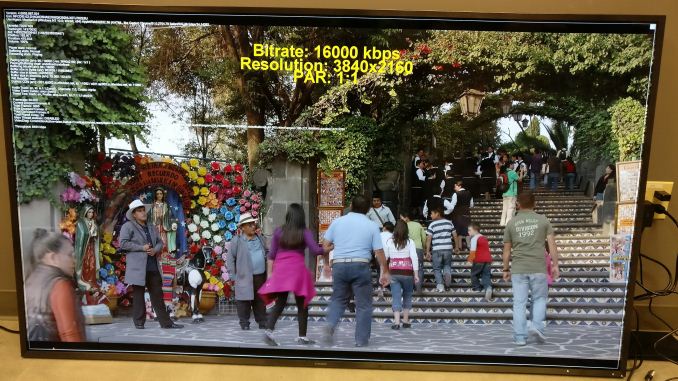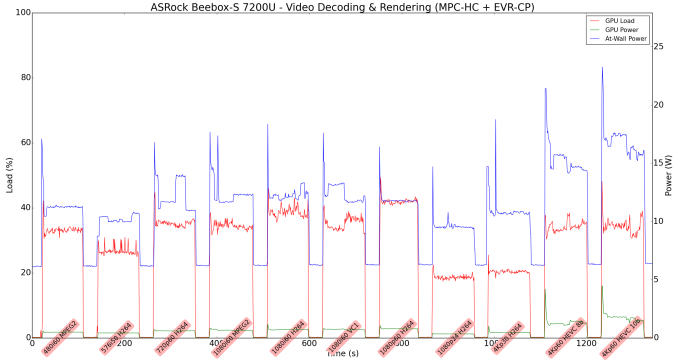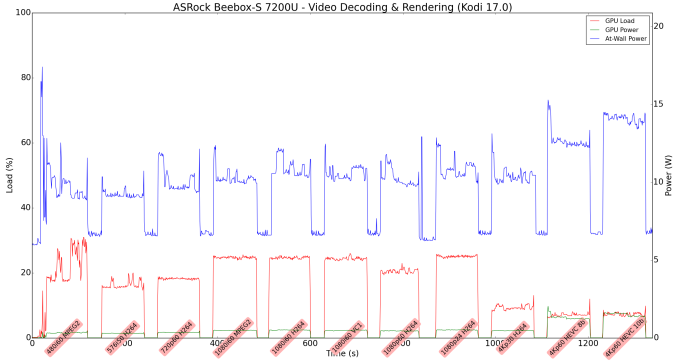ASRock Beebox-S 7200U Kaby Lake UCFF PC Review
by Ganesh T S on February 7, 2017 8:00 AM ESTHTPC Credentials
The Beebox-S series, unlike the Braswell Beebox, does not have any fanless members. However, the noise profile is attractive enough for the unit to be used as a HTPC. Operation of the Core i5-7200U at its default TDP ensures that the fan doesn't need to spin as fast as what we have seen in some of the other UCFF PCs (which configure the TDP up). However, given the specifications of the Intel HD Graphics 620, it is clear that the Beebox-S 6200U is more suited for the casual HTPC user, rather than someone who wants all the bells and whistles like customized renderers (madVR etc.). Based on this use-case, we evaluated refresh rate accuracy, over-the-top (OTT) streaming, and Kodi 17.0 for local media playback.
Refresh Rate Accuracy
Starting with Haswell, Intel, AMD and NVIDIA have been on par with respect to display refresh rate accuracy. The most important refresh rate for videophiles is obviously 23.976 Hz (the 23 Hz setting). As expected, the ASRock Beebox-S 7200U has no trouble with refreshing the display appropriately in this setting.
The gallery below presents some of the other refresh rates that we tested out. The first statistic in madVR's OSD indicates the display refresh rate.
Network Streaming Efficiency
Evaluation of OTT playback efficiency was done by playing back our standard YouTube test stream and five minutes from our standard Netflix test title. Using HTML5, the YouTube stream plays back a 720p encoding. Since YouTube now defaults to HTML5 for video playback, we have stopped evaluating Adobe Flash acceleration. Note that only NVIDIA exposes GPU and VPU loads separately. Both Intel and AMD bundle the decoder load along with the GPU load. The following two graphs show the power consumption at the wall for playback of the HTML5 stream in Mozilla Firefox (v 50.1.0).

GPU load was around 9.7% for the YouTube HTML5 stream and 0.01% for the steady state 6 Mbps Netflix streaming case.
Netflix streaming evaluation was done using the Windows 10 Netflix app. Manual stream selection is available (Ctrl-Alt-Shift-S) and debug information / statistics can also be viewed (Ctrl-Alt-Shift-D). Statistics collected for the YouTube streaming experiment were also collected here.

The Beebox-S 7200U is not particularly power efficient because our configuration uses a NVMe SSD. A SATA SSD cuts down the power numbers by around 2.5 to 3W in each of the scenarios.
One of the most interesting features of Kaby Lake PCs with a HDMI 2.0 / HDCP 2.2 port is the ability to play 4K Netflix streams. This is enabled by some content protection features introduced in Kaby Lake. In our initial trials, we were unable to get Netflix 4K to play back successfully despite being able to drive 4K @ 60 Hz to a HDCP 2.2-capable television. After some back and forth with ASRock, and getting hold of an updated LSPCon firmware and BIOS (v1.60), we were able to get Netflix 4K streams to work.
On the Beebox-S 7200U, our Netflix 4K test title was delivered as a 16 Mbps HEVC encode.
Decoding and Rendering Benchmarks
In order to evaluate local file playback, we concentrate on EVR-CP and Kodi 17.0. We already know that EVR works quite well even with the Intel IGP for our test streams. The decoder used was LAV Filters bundled with MPC-HC v1.7.10.276. We have now added HEVC streams to our test suite.
In our earlier reviews, we focused on presenting the GPU loading and power consumption at the wall in a table (with problematic streams in bold). Starting with the Broadwell NUC review, we decided to represent the GPU load and power consumption in a graph with dual Y-axes. Eleven different test streams of 90 seconds each were played back with a gap of 30 seconds between each of them. The characteristics of each stream are annotated at the bottom of the graph. Note that the GPU usage is graphed in red and needs to be considered against the left axis, while the at-wall power consumption is graphed in green and needs to be considered against the right axis.
Frame drops are evident whenever the GPU load consistently stays above the 85 - 90% mark. Like the MSI Cubi2-005BUS (which also uses the Intel HD Graphics 620), the ASRock Beebox-S 7200U has absolutely no trouble in keeping up with the media playback use-cases.
Moving on to the codec support, the Intel HD Graphics 620 is a known quantity with respect to the scope of supported hardware accelerated codecs (based on Intel's claims). DXVA Checker serves as a confirmation.
Kaby Lake-U has one of the most comprehensive codec supports in the market after Intel decided to add HEVC 8b and 10b full hardware decode. In fact, there is also support for 10-bit VP9 in the GPU. It is a pity that the display engine still doesn't support HDMI 2.0 natively, but ASRock has ensured that it is not a problem for the Beebox-S 7200U.




















33 Comments
View All Comments
Unton - Wednesday, March 15, 2017 - link
Could you advise me please,Im looking for NUC pc and choose two favorites:
This model and Zotac Zbox CI543
Does this model make some noize ?
It important because nettop will work 24 hours near my bed.
Zotac is fanless and I guest its absolutely quite, but has older processor and video.
Please help me to choose.
david123 - Wednesday, August 23, 2017 - link
Wow, it just look great. I believe it will rock and boost the system of http://192-168.bizadam22 - Friday, September 15, 2017 - link
Thanks for great review. Where can i find it at lower price ? http://www.192168.info